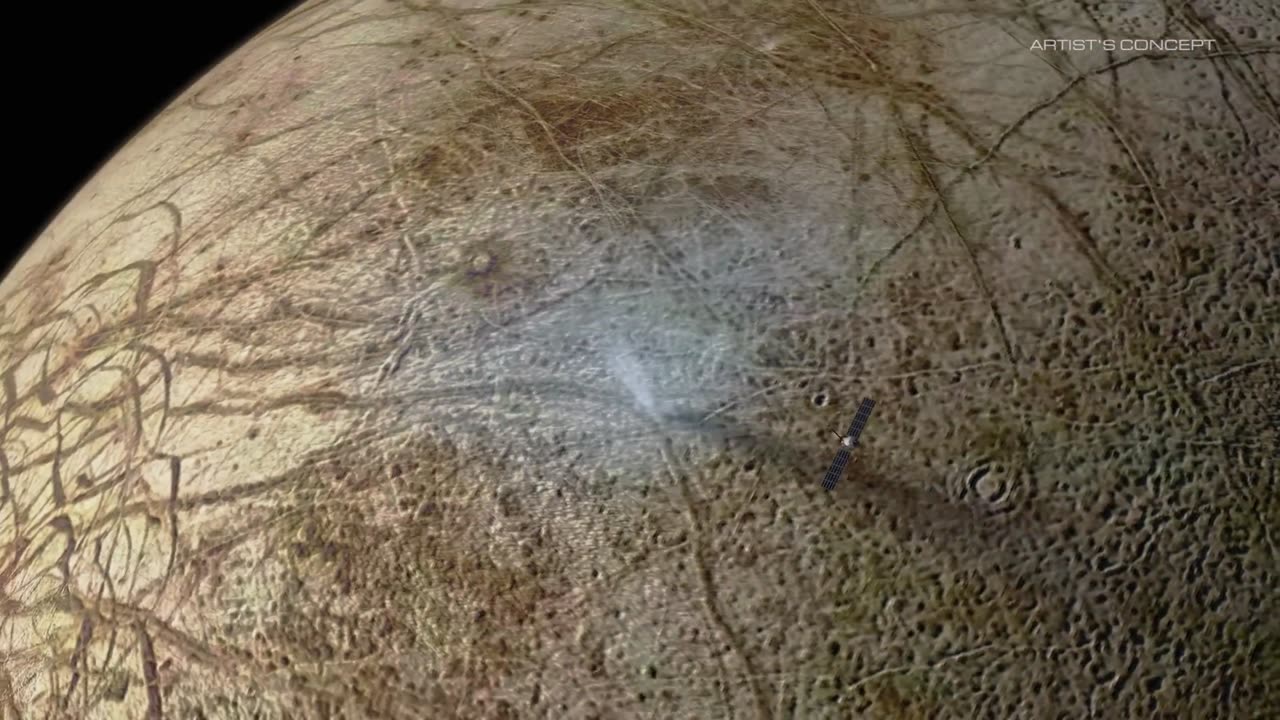Premium Only Content

Why Does NASA Want to Explore Jupiter’s Ocean Moon? (Europa Clipper Science Overview)
#europa #clipper #science #europaclipper #nasa #jupitersocean #nasaexploration #jupiterwater #nasamission #earthwater #europascience #nasascience #spacetechnology #spaceexploration #jupiter #overview #viral #trending #follow #foryou #views #rumblevideo #nasavideos
Why Does NASA Want to Explore Jupiter’s Ocean Moon? (Europa Clipper Science Overview)
Everywhere there’s water on Earth, there’s life. Does that hold true elsewhere in our solar system? NASA’s Europa Clipper mission will investigate Jupiter’s icy moon Europa, which — with its subsurface ocean — is one of the most promising places in our solar system to find environments capable of supporting life.
While Europa Clipper isn’t a life-detection mission, it will be the first to conduct a detailed survey of this icy moon to answer questions about Europa’s potential habitability and composition. The mission’s main goals are to determine the thickness of Europa’s icy shell; confirm the presence of an ocean; investigate the make-up of that ocean; and characterize the geology of the surface. The spacecraft will orbit Jupiter and make approximately 50 flybys of Europa. It’s equipped with a powerful suite of instruments that will work in sync to gather measurements and high-resolution images.
Europa Clipper is expected to launch in October 2024 from NASA’s Kennedy Space Center in Florida. It will arrive at the Jupiter system in 2030.
For more information on the mission go to: https://europa.nasa.gov/.
Credit: NASA/JPL-Caltech/APL
Why Does NASA Want to Explore Jupiter’s Ocean Moon? (Europa Clipper Science Overview)
Everywhere there’s water on Earth, there’s life. Does that hold true elsewhere in our solar system? NASA’s Europa Clipper mission will investigate Jupiter’s icy moon Europa, which — with its subsurface ocean — is one of the most promising places in our solar system to find environments capable of supporting life.
While Europa Clipper isn’t a life-detection mission, it will be the first to conduct a detailed survey of this icy moon to answer questions about Europa’s potential habitability and composition. The mission’s main goals are to determine the thickness of Europa’s icy shell; confirm the presence of an ocean; investigate the make-up of that ocean; and characterize the geology of the surface. The spacecraft will orbit Jupiter and make approximately 50 flybys of Europa. It’s equipped with a powerful suite of instruments that will work in sync to gather measurements and high-resolution images.
Europa Clipper is expected to launch in October 2024 from NASA’s Kennedy Space Center in Florida. It will arrive at the Jupiter system in 2030.
For more information on the mission go to: https://europa.nasa.gov/.
Credit: NASA/JPL-Caltech/APL
Why Does NASA Want to Explore Jupiter’s Ocean Moon? (Europa Clipper Science Overview)
Everywhere there’s water on Earth, there’s life. Does that hold true elsewhere in our solar system? NASA’s Europa Clipper mission will investigate Jupiter’s icy moon Europa, which — with its subsurface ocean — is one of the most promising places in our solar system to find environments capable of supporting life.
While Europa Clipper isn’t a life-detection mission, it will be the first to conduct a detailed survey of this icy moon to answer questions about Europa’s potential habitability and composition. The mission’s main goals are to determine the thickness of Europa’s icy shell; confirm the presence of an ocean; investigate the make-up of that ocean; and characterize the geology of the surface. The spacecraft will orbit Jupiter and make approximately 50 flybys of Europa. It’s equipped with a powerful suite of instruments that will work in sync to gather measurements and high-resolution images.
Europa Clipper is expected to launch in October 2024 from NASA’s Kennedy Space Center in Florida. It will arrive at the Jupiter system in 2030.
For more information on the mission go to: https://europa.nasa.gov/.
Credit: NASA/JPL-Caltech/APL
Why Does NASA Want to Explore Jupiter’s Ocean Moon? (Europa Clipper Science Overview)
Everywhere there’s water on Earth, there’s life. Does that hold true elsewhere in our solar system? NASA’s Europa Clipper mission will investigate Jupiter’s icy moon Europa, which — with its subsurface ocean — is one of the most promising places in our solar system to find environments capable of supporting life.
While Europa Clipper isn’t a life-detection mission, it will be the first to conduct a detailed survey of this icy moon to answer questions about Europa’s potential habitability and composition. The mission’s main goals are to determine the thickness of Europa’s icy shell; confirm the presence of an ocean; investigate the make-up of that ocean; and characterize the geology of the surface. The spacecraft will orbit Jupiter and make approximately 50 flybys of Europa. It’s equipped with a powerful suite of instruments that will work in sync to gather measurements and high-resolution images.
Europa Clipper is expected to launch in October 2024 from NASA’s Kennedy Space Center in Florida. It will arrive at the Jupiter system in 2030.
For more information on the mission go to: https://europa.nasa.gov/.
Credit: NASA/JPL-Caltech/APL
Why Does NASA Want to Explore Jupiter’s Ocean Moon? (Europa Clipper Science Overview)
Everywhere there’s water on Earth, there’s life. Does that hold true elsewhere in our solar system? NASA’s Europa Clipper mission will investigate Jupiter’s icy moon Europa, which — with its subsurface ocean — is one of the most promising places in our solar system to find environments capable of supporting life.
While Europa Clipper isn’t a life-detection mission, it will be the first to conduct a detailed survey of this icy moon to answer questions about Europa’s potential habitability and composition. The mission’s main goals are to determine the thickness of Europa’s icy shell; confirm the presence of an ocean; investigate the make-up of that ocean; and characterize the geology of the surface. The spacecraft will orbit Jupiter and make approximately 50 flybys of Europa. It’s equipped with a powerful suite of instruments that will work in sync to gather measurements and high-resolution images.
Europa Clipper is expected to launch in October 2024 from NASA’s Kennedy Space Center in Florida. It will arrive at the Jupiter system in 2030.
For more information on the mission go to: https://europa.nasa.gov/.
Credit: NASA/JPL-Caltech/APL
Why Does NASA Want to Explore Jupiter’s Ocean Moon? (Europa Clipper Science Overview)
Everywhere there’s water on Earth, there’s life. Does that hold true elsewhere in our solar system? NASA’s Europa Clipper mission will investigate Jupiter’s icy moon Europa, which — with its subsurface ocean — is one of the most promising places in our solar system to find environments capable of supporting life.
While Europa Clipper isn’t a life-detection mission, it will be the first to conduct a detailed survey of this icy moon to answer questions about Europa’s potential habitability and composition. The mission’s main goals are to determine the thickness of Europa’s icy shell; confirm the presence of an ocean; investigate the make-up of that ocean; and characterize the geology of the surface. The spacecraft will orbit Jupiter and make approximately 50 flybys of Europa. It’s equipped with a powerful suite of instruments that will work in sync to gather measurements and high-resolution images.
Europa Clipper is expected to launch in October 2024 from NASA’s Kennedy Space Center in Florida. It will arrive at the Jupiter system in 2030.
For more information on the mission go to: https://europa.nasa.gov/.
Credit: NASA/JPL-Caltech/APL
Why Does NASA Want to Explore Jupiter’s Ocean Moon? (Europa Clipper Science Overview)
Everywhere there’s water on Earth, there’s life. Does that hold true elsewhere in our solar system? NASA’s Europa Clipper mission will investigate Jupiter’s icy moon Europa, which — with its subsurface ocean — is one of the most promising places in our solar system to find environments capable of supporting life.
While Europa Clipper isn’t a life-detection mission, it will be the first to conduct a detailed survey of this icy moon to answer questions about Europa’s potential habitability and composition. The mission’s main goals are to determine the thickness of Europa’s icy shell; confirm the presence of an ocean; investigate the make-up of that ocean; and characterize the geology of the surface. The spacecraft will orbit Jupiter and make approximately 50 flybys of Europa. It’s equipped with a powerful suite of instruments that will work in sync to gather measurements and high-resolution images.
Europa Clipper is expected to launch in October 2024 from NASA’s Kennedy Space Center in Florida. It will arrive at the Jupiter system in 2030.
For more information on the mission go to: https://europa.nasa.gov/.
Credit: NASA/JPL-Caltech/APL
-
 20:31
20:31
Actual Justice Warrior
1 day agoOxford Student Who Celebrated Charlie Kirk's Murder Plays Victim
7.01K10 -
 23:40
23:40
Code Blue Cam
14 hours agoMan Celebrates Independence Day by Losing His Freedom
16.5K7 -
 58:39
58:39
MattMorseTV
11 hours ago $34.49 earned🔴Rand Paul just made a BIG MISTAKE.🔴
70.4K166 -
 24:21
24:21
The Pascal Show
9 hours ago $6.88 earned'CHALLENGE ACCEPTED!' TPUSA Breaks Silence On Candace Owens Charlie Kirk Allegations! She Responds!
20.2K7 -
 19:23
19:23
MetatronHistory
16 hours agoThe REAL Origins and Function of the PRETORIANS in Ancient Rome
15.5K -
 2:03:59
2:03:59
Side Scrollers Podcast
20 hours agoKaceytron Publicly Humiliated by H3H3 + Sabrina Carpenter/White House FEUD + More | Side Scrollers
61.2K7 -
 2:17:46
2:17:46
The Connect: With Johnny Mitchell
4 days ago $17.92 earnedA Sitdown With The Real Walter White: How An Honest Citizen Became A Synthetic Drug Kingpin
105K2 -
 2:40:08
2:40:08
PandaSub2000
1 day agoDEATH BET | Solo Episode 01 (Edited Replay)
29K1 -
 9:41
9:41
Blabbering Collector
2 days agoHarry Potter Vintage Christmas Merch By Realtec Canada!
12.9K1 -
 LIVE
LIVE
Lofi Girl
2 years agoSynthwave Radio 🌌 - beats to chill/game to
615 watching